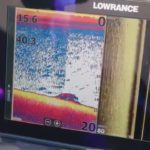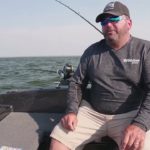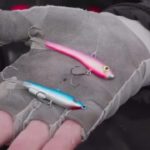Total Solutions – Vertical Jigging Riprap
Anytime you are fishing along riprap, whether that is a dam, long shoreline, or any sort of manmade structure that is used to prevent shoreline erosion, it is a safe bet that many species of fish will congregate in the area. The porous rock attracts plankton, baitfish, and then of course, the predators. The riprap most generally extends into the water quite a ways creating subsurface structure that you need to spend time picking apart.
Keying in on specific areas where the riprap transitions to a softer bottom, or where the riprap extends into deeper water creating a distinct depth change can be extremely productive. However, there are times when walleye will suspend keyed in on a pod of baitfish, or above portion of well-defined rock pile. Sometimes casting or trolling crank baits just won’t trigger the neutral or negative fish. A more subtle approach will be required, as walleyes are known for being persnickety from time to time. This is the time to go vertical.
Riprap is typically quite snaggy and live bait will often not withstand much of the damage they will obtain when coming in contact with the rock. This is an ideal situation where artificial presentations really shine. Since walleye are a school-oriented fish, they tend to bunch up, so when you catch one, more fish are likely in the same location. The use of quality electronics is essential to locating and staying on top of the school.
Total Solutions Technique
“I like to keep my presentation above the rocks for several purposes, but in close proximity,” explains decorated walleye pro, Mike Gofron. “I like to keep the bait within a foot of the bottom by using a method known as ‘touch and lift’, I’ll touch the bottom a lot less and swim the bait more often. However, knowing specifically where your bait is in relation to the bottom is essential to keeping your presentation in front of the fish. I prefer straighter water that doesn’t have strong current or turbulence, as the fish prefer to be comfortable and you are more able to control the bait. Walleyes will stage where they can ambush the bait quickly and they will often react in a manner where they don’t have an ample amount of time to evaluate the bait.”
“For the most part the fish are located along the riprap to feed or spawn, depending on the time of year,” Gofron continues. “Under colder water conditions, a three-way swivel with a drop-weight on it hanging below a single hook with a live shiner or a Berkley Gulp! Alive Minnow can be extremely productive. Visualizing the riprap break is crucial in presenting your bait. Often times, you need to get your bait down to deeper water and a heavier jig head, (maximum weight would be about ¼ ounce) will help with that and I like to use that bait to contact the bottom and retrieve it from there to where the suspended fish are located. This helps me keep the presentation in the strike zone for a longer period of time, thus maximizing the amount of fish I come in contact with.”
“When jigging with artificial presentations, I like to keep bounce and lift the jig and hold the jig for slightly longer than I would with live bait,” he explains. “It is also important to note the eye position of the jig. I have found the horizontal position to be most effective when fishing suspended walleyes.”
Total Solutions Equipment
Gofron prefers a medium-sized spinning reel on a 6’ medium-light action rod. He loads his reels loaded up with 6/2 (pound/diameter) Flame Green Berkley FireLine as this allows you to keep in better contact with the bottom and your presentation. Berkley Gulp! Alive Minnows are his preferred presentation when vertical jigging. If the fish are biting a four-inch Gulp! Alive Minnow but getting the fish hooked is difficult, he suggests going to a three-inch Gulp! Alive Minnow. If you need to downsize even further, Gofron recommends trimming the bait down until you are putting more hooks into the fish.
He also suggests using a larger hook gap for the artificial presentations as he feels the hooking percentage is increased dramatically, especially since you won’t be worrying about keeping live bait alive. Let the fish tell you what they want and your hooking percentage will skyrocket.





